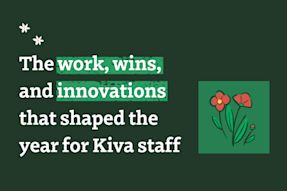One school shows it's never too early to make a difference
July 8, 2018By: Olivia Cornfield


Every year, 5th grade students in Rene deBerardinis’ social entrepreneurship class at Springside Chestnut Hill Academy in Philadelphia, PA, learn about microfinance through an experiential class project. The project gives students the opportunity to become both borrowers and lenders. First, students form product teams to create business plans for small venture ideas. Students receive microloans to purchase the supplies they need to implement their ideas, and pay back their loans with the sales they make at an annual Kiva-branded market. The profits from their sales then go toward making loans to borrowers on Kiva’s website.
This year, deBerardinis’ students designed a variety of imaginative business ventures, selling tie-dye headbands, a tic-tac-toe game-in-a bag, a magnetic fishing game, pet rocks, metal-stamped bracelets, trading cards, original picture and comic books, a lego car kit-in-a-tin, notecards, magnets, and embroidered canvas bags.
This project gives students the opportunity to exercise their creativity and practice forming innovative solutions to design challenges. One student noted some of the challenges their team faced. “It was hard to cut and glue the little felt fish for our magnetic fishing game," the student said. "But we made different colored and different shaped fish and glued magnets inside them. Then we made a mini fishing rod with a twig and rope and a magnet tied at the end — and put everything in an Altoids tin. The little kids really like to use the stick to try and catch the fish!”

Another student explained that their group learned how to use an embroidery machine to make their product. But learning about microfinance, problem solving, and new skills weren't the only outcomes of the Kiva project — students had loads fun.
“Our pet rocks were hard to paint," one of the students said. "But it was fun to draw the faces on them, add the hair or feathers, and then the googly eyes — which were pretty funny. We even added mustaches made of yarn to some of the rocks!”
While some students enjoyed completing the project's design process the most, other students favored the experience of selling their creations to the community.
“My favorite part was selling all the things we made at the Kiva Fair," a student said. "And seeing how much money we made for Kiva.” The project came full circle when the students, who were borrowers themselves, used the profits they made at the Kiva Fair to make Kiva loans. “I liked making the loans with Kiva because you could pick different countries, or kinds of business you wanted to support — and then we could look at the photos and read about their business and family and then pick one!”
DeBerardinis’ class project shows students that their actions can make a difference in the world, and that regardless of age, any individual can apply her creativity and curiosity to pursue social justice. “It feels good to help so many people and to know where our money is going to and then to get it back and get to pick someone else to help,” one of the students said.
You can learn more about deBerardinis’ Social Entrepreneurship course by checking out their class blog!
PREVIOUS ARTICLE
Building a brighter future in Kenya through youth entrepreneurship →NEXT ARTICLE
Why we should embrace failure to grow impact, and why it’s much easier said than done →












